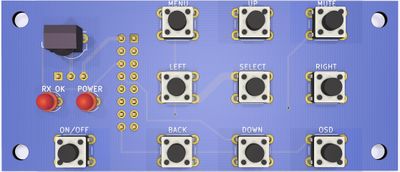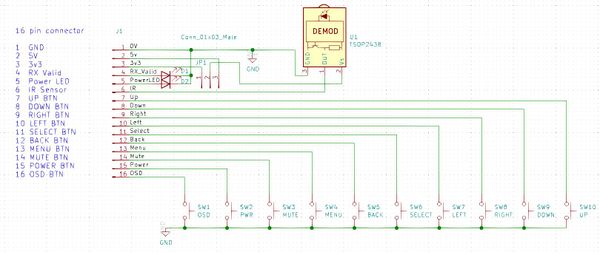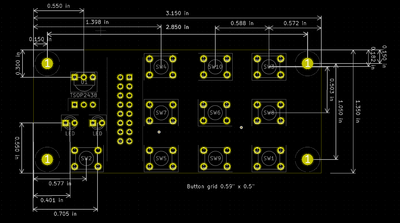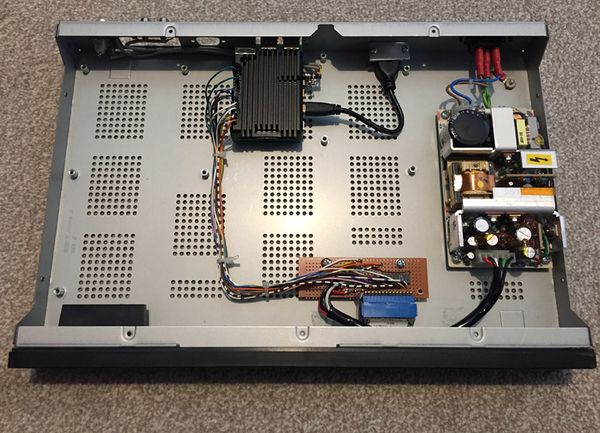Difference between revisions of "Ryde Hardware"
| (5 intermediate revisions by 2 users not shown) | |||
| Line 5: | Line 5: | ||
* Raspberry Pi 4 and heatsink / fan | * Raspberry Pi 4 and heatsink / fan | ||
* 5 volt 3 amp PSU - this may be connected directly to the RPi GPIO pins, see [[Ryde GPIO Connections]] | * 5 volt 3 amp PSU - this may be connected directly to the RPi GPIO pins, see [[Ryde GPIO Connections]] | ||
| − | * Sandisk Ultra | + | * Sandisk Ultra 8 GB or larger SD card - Pre-programmed cards are available from the BATC shop |
* Micro to standard HDMI converter - needed to connect the RPi HDMI output to a standard monitor | * Micro to standard HDMI converter - needed to connect the RPi HDMI output to a standard monitor | ||
* IR receiver and remote control - see this wiki page for more details:[[Ryde remote controls]] | * IR receiver and remote control - see this wiki page for more details:[[Ryde remote controls]] | ||
| − | * MiniTiouner V2 hardware - the Ryde | + | * MiniTiouner V2 hardware - the Ryde version 1 connects to the [[MiniTiouner hardware Version 2|standard MiniTiouner hardware]] via the Raspberry Pi USB port |
===Ryde GPIO connections=== | ===Ryde GPIO connections=== | ||
| − | + | To enable easy contruction of the Ryde Receiver, the BATC has made a small daughter board to connect to the GPIO connector on the Raspberry Pi. | |
| + | Details can be found here [[Ryde GPIO breakout]] board. | ||
| − | + | The Raspberry Pi 4 GPIO pinout listing for the Ryde is here: [[Ryde GPIO Connections]] | |
| − | + | A Parts List for the GPIO Breakout Board and the Button Panel is here [[:File:Ryde GPIO - PB Parts V1-2.xlsx]] | |
===Ryde front panel=== | ===Ryde front panel=== | ||
| Line 27: | Line 28: | ||
There are no components to fit other than push buttons, LEDs and IR sensor (see below). The buttons are standard B3F e.g. Omron B3F-1070, RS stock number 686-6907 (Two off pack of 5) or Ebay. The sensor was Vishay TSOP2438, RS stock number 180-8012, and will need its body bending upwards at a right angle, so the lens on the sensor looks through a hole in the front panel (not shown in the render above). | There are no components to fit other than push buttons, LEDs and IR sensor (see below). The buttons are standard B3F e.g. Omron B3F-1070, RS stock number 686-6907 (Two off pack of 5) or Ebay. The sensor was Vishay TSOP2438, RS stock number 180-8012, and will need its body bending upwards at a right angle, so the lens on the sensor looks through a hole in the front panel (not shown in the render above). | ||
| + | |||
| + | Schematic for those who want to build their own: | ||
| + | |||
| + | [[File:ryde PB schematic.JPG|600px]] | ||
A blank PCB is available from the BATC shop https://batc.org.uk/shop/ryde-push-button-front-panel-pcb/ | A blank PCB is available from the BATC shop https://batc.org.uk/shop/ryde-push-button-front-panel-pcb/ | ||
| Line 60: | Line 65: | ||
The HDMI display should be connected to the primary HDMI output - that's the one nearest the USB-C port and SD Card. Audio will then be sent to the HDMI device. In this case there is no audio or video from the RPi 3.5 mm jack. | The HDMI display should be connected to the primary HDMI output - that's the one nearest the USB-C port and SD Card. Audio will then be sent to the HDMI device. In this case there is no audio or video from the RPi 3.5 mm jack. | ||
| + | |||
| + | If your MiniTiouner is in the same box as your Raspberry Pi, make sure to mount the tuner inputs well away from the Raspberry Pi HDMI output cable. Simple coupling between the HDMI output cable and the tuner input cables/connectors can put spurii over the tuner input range and significantly reduce the sensitivity and MER. | ||
If composite video output is selected from the ssh console menu, then video (selectable PAL or NTSC) and audio is available on the RPi 3.5 mm jack and the HDMI outputs will be inactive. | If composite video output is selected from the ssh console menu, then video (selectable PAL or NTSC) and audio is available on the RPi 3.5 mm jack and the HDMI outputs will be inactive. | ||
Latest revision as of 09:27, 7 December 2020
The Ryde Receiver is based around a Raspberry Pi 4. Current developments are using 2 GB memory models. Future enhancements may require 4 GB or 8 GB, but no specific requirement has been identified yet.
The hardware required is as follows:
- Raspberry Pi 4 and heatsink / fan
- 5 volt 3 amp PSU - this may be connected directly to the RPi GPIO pins, see Ryde GPIO Connections
- Sandisk Ultra 8 GB or larger SD card - Pre-programmed cards are available from the BATC shop
- Micro to standard HDMI converter - needed to connect the RPi HDMI output to a standard monitor
- IR receiver and remote control - see this wiki page for more details:Ryde remote controls
- MiniTiouner V2 hardware - the Ryde version 1 connects to the standard MiniTiouner hardware via the Raspberry Pi USB port
Ryde GPIO connections
To enable easy contruction of the Ryde Receiver, the BATC has made a small daughter board to connect to the GPIO connector on the Raspberry Pi.
Details can be found here Ryde GPIO breakout board.
The Raspberry Pi 4 GPIO pinout listing for the Ryde is here: Ryde GPIO Connections
A Parts List for the GPIO Breakout Board and the Button Panel is here File:Ryde GPIO - PB Parts V1-2.xlsx
Ryde front panel
For those not using an old STB case and front panel, Mike G0MJW has designed a front panel with 10 push buttons.
There are no components to fit other than push buttons, LEDs and IR sensor (see below). The buttons are standard B3F e.g. Omron B3F-1070, RS stock number 686-6907 (Two off pack of 5) or Ebay. The sensor was Vishay TSOP2438, RS stock number 180-8012, and will need its body bending upwards at a right angle, so the lens on the sensor looks through a hole in the front panel (not shown in the render above).
Schematic for those who want to build their own:
A blank PCB is available from the BATC shop https://batc.org.uk/shop/ryde-push-button-front-panel-pcb/
Most people will want to wire their own front panel with a layout that suits them, however gerber files for the above are here which should be compatible with the PCB suppliers should you so wish.
Here is a 3D template
Ryde Infra Red sensors and remote controls
More details on how to add an IR sensor and what remote controls you can use is here: https://wiki.batc.org.uk/Ryde_remote_controls
There are no components to fit other than the push buttons, LEDs and IR sensor. The shorter lead of the two LEDs goes to the square pad on the PCB
Note that the PCB was designed for a TSOP2438 IR Sensor which has the pin connections: 1 = OUT, 2 = Vss, 3 = Gnd. Other sensors (such as the TSOP4438) have pin connections 1 = OUT, 2 = Gnd, 3 = Vss. Some sensors require +5 V supply, others require +3.3 V, but it is important that no more that 3.3 V is applied to the Raspberry Pi GPIO pin. Please check carefully before applying power!
Blank PCBs are available from the BATC shop. https://batc.org.uk/shop/ryde-gpio-pcb/
Video and Audio Output
The HDMI display should be connected to the primary HDMI output - that's the one nearest the USB-C port and SD Card. Audio will then be sent to the HDMI device. In this case there is no audio or video from the RPi 3.5 mm jack.
If your MiniTiouner is in the same box as your Raspberry Pi, make sure to mount the tuner inputs well away from the Raspberry Pi HDMI output cable. Simple coupling between the HDMI output cable and the tuner input cables/connectors can put spurii over the tuner input range and significantly reduce the sensitivity and MER.
If composite video output is selected from the ssh console menu, then video (selectable PAL or NTSC) and audio is available on the RPi 3.5 mm jack and the HDMI outputs will be inactive.
There is no current configuration which will output audio on the RPi Jack whilst the HDMI monitor is in use, or that will send output to both the HDMI and RPi 3.5 mm jacks simultaneously.
Project cases
Most of the early development protypes are being hosted on old STB cases - these provide a case, possibly a PSU and IR detector diode and front panel switches.
An example prototype hardware is shown here:





